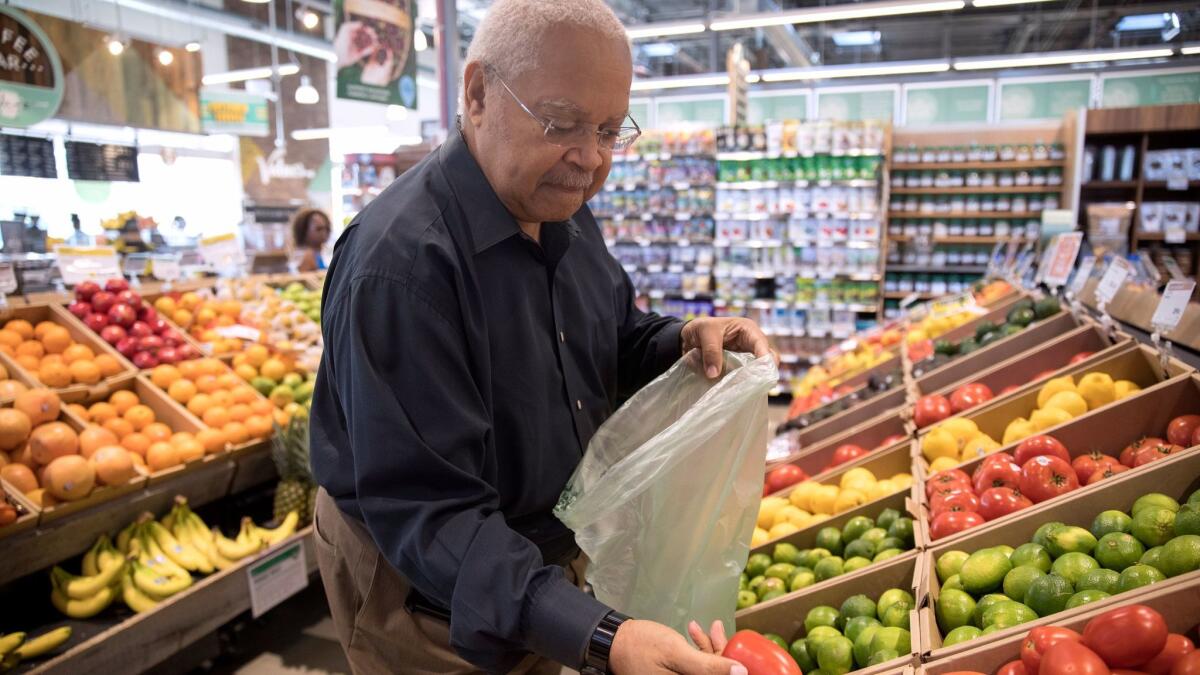Amazon vowed to make Whole Foods cheaper. Let’s see how that’s going

Amazon.com Inc.’s takeover of Whole Foods Market began five weeks ago with a lot of fanfare about lower prices.
And while the grocery chain has strategically marked down select items like avocados and almond milk, overall prices have dropped very slightly — about 1% — since Amazon took ownership, according to an analysis by research firm Gordon Haskett.
The firm tracked prices on 110 items over five weeks at a Whole Foods location in Princeton, N.J., and found that, on average, prices are down 1.2% since Amazon finalized its $13.7-billion purchase of the grocer. (Jeff Bezos, the founder and chief executive of Amazon, owns the Washington Post.)
And although Amazon offered discounts on a number of items right away, some of those prices have crept back up, according to the data. The price of frozen foods, for example, was 7% higher on Sept. 26 than on Aug. 28, when Amazon officially took over. Snack items rose 5.3% in that period, and dairy and yogurt were up 2%. (Among categories where prices are lower: beverages, down about 2.8%; bread and bakery, down 6.8%; and produce, down 0.5%.)
Whole Foods — nicknamed by some as “whole paycheck” — has struggled for years to shed its reputation for overpricing. The company’s prices have historically been about 15% higher than at the average grocery store, according to Morgan Stanley.
Amazon seized on that long-standing customer complaint by announcing that its first move would be to cut prices. From the beginning, the company said customers would see a series of discounted staples at local stores: extra-large brown eggs for $3.19 instead of $3.49, organic apples for $1.99 a pound instead of $2.99 and Haas avocados for $1.49 apiece instead of $2.
It was no mistake, analysts said, that many of the markdowns were on everyday items that families tend to buy on a regular basis. The average shopper, they said, is more likely to notice a lower price on a carton of eggs than on a tin of anchovies.
“The whole game is that you want the 100 most recognizable things — milk, apples, bananas — to be cheaper,” said Jan Rogers Kniffen, an industry consultant and former department store executive. “If you can do that, you can build a perception that the whole store is competitively priced.”
It’s a model, he said, that Wal-Mart Stores Inc., which is Amazon’s biggest competitor in the grocery space, has fine-tuned over the years. And there are signs that the publicity surrounding the markdowns was enough for some customers to give Whole Foods another chance. Data from location-based app Foursquare found a 25% increase in shoppers in the days after the Amazon takeover.
“The bottom line is, the lower prices got people into their stores,” said Phil Lempert, a California-based food industry analyst known as the “supermarket guru.” “People who hadn’t been there in years were suddenly thinking, ‘Maybe I should give it a try.’ This was a clear sign to shoppers — and the industry — that Amazon is serious about fixing things up.”
The Whole Foods deal already has been lucrative for Amazon. Since the takeover, Whole Foods has generated $1.6 million in sales through Amazon.com and its services, including Amazon Fresh and Prime Now, according to e-commerce analytics firm One Click Retail. (During the first week, Whole Foods products were so popular on Amazon that 93% of them sold out, according to One Click Retail.) Among the most popular purchases: turkey deli meat, coconut water and frozen vegetables.
But the data from Gordon Haskett also show that while some prices are lower, others have gone up. Of the 110 items the firm tracked, prices decreased for 17 items and increased for 16 items. The vast majority of prices — on 70% of the items — remained the same.
The items that were discounted, such as breads baked in house and selections from Whole Foods’ private label brand 365, often have higher profit margins and more wiggle room for markdowns, Lempert said. Items such as frozen foods — a category where prices have climbed since Amazon took over — are harder to discount, he said, because they must be kept cold both in store and during transit.
“Frozen foods, which is a declining category anyway, uses the most energy of any department in the store,” he said. “It’s much easier for Amazon to say, ‘We’ll charge less for bananas.’ ”
But, industry analysts said, the grocery business is a notoriously difficult one with slim profit margins. Lowering prices in one area often means having to make up for those discounts elsewhere.
“Like all grocery stores, if prices are lowered someplace, prices are raised someplace else,” said David J. Livingston, a supermarket analyst for DJL Research. “Just like when a grocer claims to have lowered 5,000 prices. What they don’t tell you is they raised prices on 45,000 items to pay for it.”
Bhattarai writes for the Washington Post.
ALSO
Elizabeth Warren slams Wells Fargo CEO as wrong person to lead bank’s turnaround
David Lazarus: Average CEO has to make do with $253,088 in monthly pension payments
‘I don’t think we can pass a law that fixes stupid’: Lawmakers berate Equifax ex-CEO
Wal-Mart, trying to hone its same-day delivery skills, buys New York’s Parcel
More to Read
Inside the business of entertainment
The Wide Shot brings you news, analysis and insights on everything from streaming wars to production — and what it all means for the future.
You may occasionally receive promotional content from the Los Angeles Times.










